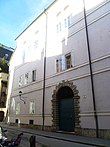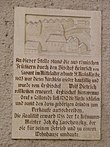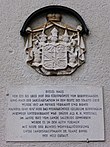Kaigasse and Krotachgasse
The Kaigasse located in the old town of Salzburg and has developed along the former main street procession from the Cathedral over the Kajetanerplatz (later Kajetanertor) over the Erentrudistor to Hallein and Berchtesgaden . The current lane consists of several medieval streets and was gradually built from the 12th century.
A small connecting lane leads from Kaigasse to Pfeifergasse , which is called Krotachgasse . The name of this Krotachgasse is reminiscent of an old, slowly flowing brook that stretched from the Festungsberg over the Krotachgasse into the Gries of the Salzach and that was once known to be rich in toads (Krot-Ach, Krötenache).
Well-known buildings on Kaigasse
The former church of St. Salvator
The protruding house at Kaigasse 4 emerged from the former Salvatorkirche (Red Brotherhood Church, see below). This house is mentioned for the first time in 1421 and from the beginning it belonged to the cathedral capital hospital there, which rented it to townspeople. Archbishop Wolf Dietrich von Raitenau finally had the building demolished, which often gave rise to disputes over interest rates and the payment of repairs. Under his successor Markus Sittikus von Hohenems , the St. Salvator Church was built here in 1618 and consecrated in 1619, which also became the seat of the Corpus Christi brotherhood. During the Counter Reformation this brotherhood was a well-known religious lay brotherhood, which was also called the Red Brotherhood because of its typical red robes. The church had a marble portal with the coat of arms of Archbishop Markus Sittikus and a high church gable, which was crowned by a small dome with a cross. The pediment showed a picture of the Holy Trinity with two angels worshiping. The side windows of the church were largely blind between the adjacent town houses. The church was last renovated again in 1788 under the master mason Laschensky, but then it was finally abandoned as a church in 1805, after it had served as a binder workshop as early as 1800. The church gable was removed between 1890 and 1895 and replaced with a new hipped roof. Today the house has a baroque facade. The interior of the community center was rebuilt several times in the 19th and 20th centuries.
The Red Brotherhood sacristan's house
This, in essence, late-Gothic house at Kaigasse 6, which was later given the Baroque style, first belonged, like the neighboring house, to the cathedral capital hospital. Prince Archbishop Wolf Dietrich had it largely demolished in order to be able to build the sacristan's house of the Salvator Church here. The large niche in the garden of the house at Kaigasse 6 was long interpreted as the former apse of the Salvatorkirche, in fact there was probably a small garden in Wolf Dietrich's pleasure garden. The Red Mesnerhaus was auctioned off in 1805, and the fruit trader Dismas Widerwald won the bid. Today the portal to the street bears the year 1897 and the letters WL (Werner Laschensky).
The Schneiderherberg (Hotel Weisse Taube)
(Kaigasse 9)
Today this house is the hotel or the inn "White Taube". The house was first mentioned (1365) as the "House against the Tumber Spital" (house near the Cathedral Hospital). In 1491 the Schneiderzeche (tailors' guild) bought this house and used it as a hostel until 1809. In 1809, Josef Reisenberger acquired the building, who gave the house the name “Gasthaus zum golden Frieden” during the Napoleonic Wars (named after the Peace of Schönbrunn ). In 1904, municipal councilor Josef Haubner bought the house, and since then it has been called “Zur Weißen Taube”. Today the hotel and guest house is run by the fifth generation of this family.
The old cathedral deanery
(Kaigasse 12 = Kapitelgasse 6)
The stately house on the corner of Kapitelgasse was built between 1605 and 1613. In the previous building, the "Keutschachhof", Prince Archbishop Wolf Dietrich von Raitenau lived after his election until the reception of the pallium . On the edge of the house there is a coat of arms of the first builder Wolf Dietrich von Raitenau. The house is the former Domdechantei, in whose square inner courtyard the Trakl Fountain, which Toni Schneider-Manzell created in 1957, now stands . In 1675, cathedral dean Wilhelm Freiherr von Fürstenberg lived here.
Also noteworthy is the garden grotto in the side courtyard, which has a richly stuccoed barrel vault. Four round medallions show busts of Roman emperors. The grotto was built around 1613 in the Sil Hellbrunn. The adjacent Sala terrena was added by Fürstenberg in 1678. After this garden hall, the grotto is now known as the Sala terrena grotto. Fürstenberg also had the two-storey bay window that still exists today built on the Kapitelgasse facade. Many of the building's stucco ceilings were made around 1707. During the time of the monarchy, the Imperial and Royal Nursing Court (later a district court) was housed here.
The Högelwörther Hof
(Kaigasse 17)
First mentioned in a document in 1434 as Högelwörther Hof, at that time the court served as the city palace of the abbots and prelates of the Höglwörth monastery (the abandoned monastery is now in Upper Bavaria). In 1604, at the instigation of Wolf Dietrich von Raitenau, the Salzburg cathedral chapter took over the house for the canons. At times it was also called “Prince Schwarzenbergischer Kanonikalhof”. After the end of Fürsterzbistums 1810, the house was ärarischen property of the monarchy rebuilt and given a new facade. The Kapitelarm of the Almkanales flows under the house on the northern boundary .
The former church of St. Nicolai
(Nicolaistöckl, Kaigasse 20)
The house on the corner of Herrengasse emerged from the former Nicolaikirche. The Church of St. Nikolai was built in the Middle Ages by an unnamed Bishop of Lavant and had two altars, one in honor of the Apostle Matthias and one in honor of St. Nicholas. Wolf Dietrich von Raitenau had the dilapidated Gothic church, which obviously no longer corresponded to the taste of the time, largely torn down and replaced it in 1603 with a new church that was consecrated to St. This church was also the seat of the lay brotherhood “All Christian Souls” (All Souls Brotherhood) and a branch church of the cathedral parish. Quite a few Salzburg countrymen and noble ship owners from Salzach boatmen (called Erbausfergen) owned a family tomb in this church. In 1782 the church was abandoned and sold under Archbishop Hieronymus von Colloredo . The master mason Laschensky built the former church as a buyer to use it as a residential building. It was then that the facade that is still visible today was created.
The Kasererbräuhaus
(Altstadthotel Kasererbräu and Mozartkino, Kaigasse 33)
The essentially late Gothic house is first mentioned in documents in 1421 as a brewery inn and again in 1526 as "Georg Stellner's Brewhouse". In 1713 it bears the name “Kässerers Würthsbehausung beim Weiße Lewen” (Kaserer's inn at the White Lion) and in 1775 it was first called Kasererbräu. The facade of the house dates from the end of the 18th century.
The Mozartkino built here is the oldest existing cinema in Salzburg and its predecessors go back to 1905. "Frieds Original-Elektro-Biograph" showed moving pictures on the first floor of the house.
The part of the house facing away from the street was badly damaged by aerial bombs during World War II . During the reconstruction of the destroyed parts of the house, a Roman temple was found under the later cinema hall. In 1948 the Mozartkino was housed in its current premises. When the cinema was rebuilt again in 1987, a fountain was recovered in the course of further excavations in the area of the Roman temple and is exhibited in the Carolino Augusteum Museum. The hall in the basement is called Roman cinema today, after the temple parts underneath and exposed wall remains.
In 2008 the cinema was merged with the Altstadthotel Kasererbräu. A switch to digital projectors failed because of the costs and so the Mozartkino was closed in August 2013.
Thanks to the business driver Altstadthotel Kasererbraeu and the support of the State of Salzburg, the Mozartkino was able to reopen on November 7, 2014 with new digital projectors.
The Roman temple complex
The winding street also results from a Roman temple complex, designed as Peripteros , which was dedicated to the gods Asklepios , Hygieia and Cybele . It once stood between today's streets Kaigasse and Krotachgasse. Its foundation walls were excavated in 1945–1955 and 1987. The length of the temple was 100 Roman feet (45.5 m) and the width 100 feet (29.6 m). The strong foundations of the temple were partly made using the casting technique.
The Krotachgasse and its ecclesiastical mansions
The Chiemseehof
The Chiemseehof is one of the great ecclesiastical mansions that existed in the city of Salzburg during the time of the archbishopric. As the Archbishop's deputy, the Bishop of Chiemsee (appointed by the Archbishop) also had important tasks in Salzburg.
The Chiemseehof was first mentioned in 1216 and expanded into the residence of the bishops of Chiemsee around 1300. The courtyard chapel was inaugurated in an enlarged size, which one could confidently call a church, in 1497. The building complex remained the seat of these bishops until 1812. It was rebuilt in a sober style during the Aryan period of the Habsburg monarchy. The Archbishops of Salzburg resided here from 1812 to 1861. Since 1861 it has been the seat of the Salzburg state parliament and the Salzburg state government. Today's meeting room of the state parliament was set up in a building that Bishop Silvester Phlieger (1438-1451) had built as a grain bin. Some coats of arms and inscriptions are reminiscent of the glamorous times of the prince-archbishop.
The Berchtesgadener Hof
The Berchtesgadener Hof was the seat of the prince-provost of Berchtesgaden in the time of the prince- archbishop . At the time of Pilgrim II von Puchheim, Berchtesgaden was part of the secular territory of the Prince Archbishopric of Salzburg for a few decades , but then became a (very small) independent spiritual principality in the Roman-German Empire. Berchtesgaden remained part of the Salzburg archdiocese until the end of the prince-archbishopric . In 1813 this farm was sold to the Berchtesgaden provosts because Berchtesgaden had now become Bavarian. Between 1840 and 1847 the building was rented to the newly founded Archbishop's College for Boys, from which the Collegium Borromaeum emerged in 1849 after moving to the rebuilt Primogeniturpalast , and in 1879 the private grammar school Borromaeum . After that, the kuk post stable was housed here. In 1882 it was acquired by the State of Salzburg and rebuilt in 1931.
In addition to the large manor house, the Berchtesgadenerhof “im Krotach” included four small buildings, including the Caplaneihäusel and the house of the Berchtesgaden court judge. The small chapel in the Berchtesgadener Hof has been preserved, but most of the building, together with the closest Gurkerhof, fell victim to American aerial bombs during World War II and was rebuilt in a new style.
The Gurkerhof
The court of the Prince-Bishop of Gurk was originally also in Kaigasse or in the area of today's new residence. It was demolished by Prince Archbishop Wolf Dietrich in the course of redesigning the city. The Gurkerhof in Krotachgasse was then called "House of the Bishop of Gurk".
This newer Gurkerhof was first mentioned in 1424, when Ernst Bishop von Gurk gave this farm to the sons of the Salzburg captain Virgil Uiberackers - and thus the Sighartstein line of the family. This line of the noble family died out around 1747, which is why the court reverted to the cathedral chapter , which auctioned the court to the Salzburg aristocratic family Hagenauer in 1748 . After the destruction of the Second World War, the house was rebuilt.
Others
In memory of the victims of National Socialism, several stumbling blocks were laid in Kaigasse 8 and 20 and in Krotachgasse 2 by the Cologne artist Gunter Demnig and the Salzburg personal committee .
Individual evidence
- ↑ Rupert Klieber: Brotherhoods and associations of love after Trient . Peter Lang, Frankfurt am Main a. a. 1999, ISBN 3-631-34044-3 , pp. 145 .
- ↑ The Mozart cinema in the Hotel Kasererbraeu. Altstadthotel Kasererbraeu Salzburg, accessed on February 9, 2014 .
- ↑ History of the Mozart Cinema ( Memento of the original from November 29, 2014 in the Internet Archive ) Info: The archive link was inserted automatically and has not yet been checked. Please check the original and archive link according to the instructions and then remove this notice. , Mozartkino the cinema in Salzburg
- ↑ History: From a shared apartment to a Catholic private high school borromaeum.at
Web links
swell
- Bernd Euler, Ronald Gobiet, Horst Huber: Dehio Salzburg - City and Country. Verlag Anton Schroll & Co, Vienna 1986, ISBN 3-7031-0599-2 .
- FW Zillner; History of the City of Salzburg, - special volumes of the Society for Salzburg Regional Studies, Salzburg 1885.
Coordinates: 47 ° 47 ′ 50 ″ N , 13 ° 2 ′ 56 ″ E









